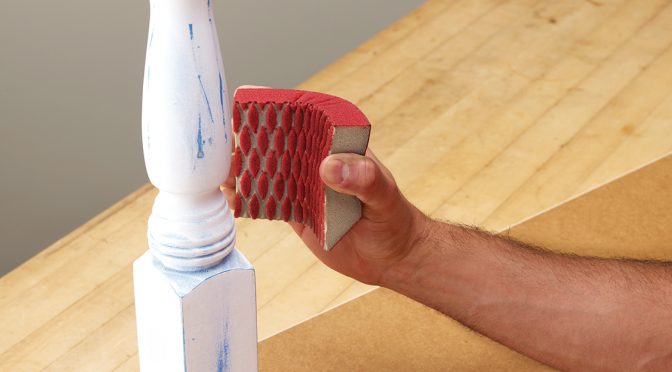For the Summer 2018 issue of PPC magazine, we sat down with the technical services team in 3M’s Construction & Home Improvement Markets Division to compile The Pro Painter’s Guide to Sanding. As a companion to that story, we’ve put together this how-to guide based on the different types of surfaces pro painters are likely to encounter.
You can generally gauge the type of sanding that will be needed by thinking about the type of surface you’ll be working with.
Walls
- Not much sanding is typically needed unless you have dings, nail pops, or a hole. If you do, you’ll need to do some patching and then sanding prior to painting.
- You might want to do a light sand with fine abrasives to remove any small imperfections and to ensure better paint adhesion.
- If you do a light sand, choose an abrasive sheet that attaches easily to a hand or pole sander. If you’re spot-sanding dry mud or patching compounds, consider an abrasives sponge that resists loading. And be sure to tack off any sanding dust using a tack cloth.
Trim/molding/cabinets/furniture
- If it’s new, there won’t be much sanding required. You might want to do a light sand with fine abrasives to remove any imperfections.
- If you do a light sand, be sure to tack off any sanding dust using a tack cloth.
- If it’s been in place a while, you’ll need to sand out any scratches. Any holes should be filled with wood fillers, and you’ll want to sand that to smooth out the surface.
Staining wood
- Strip off any old stain.
- Sand down – with the grain – and rough up the entire surface to absorb new stain.
- Sand – again, with the grain – between coats of polyurethane.
- Always work through a sequence of abrasives grits, from coarse to very fine, skipping no more than one grit between stages.
Note: Read before sanding!
*WARNING! Removal of old paint by sanding, scraping or other means may generate dust or fumes that contain lead. Exposure to lead dust or fumes may cause brain damage or other adverse health effects, especially in children or pregnant women. Controlling exposure to lead or other hazardous substances requires the use of proper protective equipment, such as a properly fitted respirator (NIOSH approved) and proper containment and cleanup. For more information, call the National Lead Information Center at 1-800-424-LEAD (in US) or contact your local health authority.
More resources
Get more expert surface prep insights in our story, The Pro Painter’s Guide to Masking: Tips, Techniques and the Latest Technological Advances.
This article was originally published in the Summer 2018 issue of PPC magazine. It was developed in collaboration with the technical services team in 3M’s Construction & Home Improvement Markets Division. For more information, contact Michelle Rookey, Technical Service Manager, at mjrookey@mmm.com.

